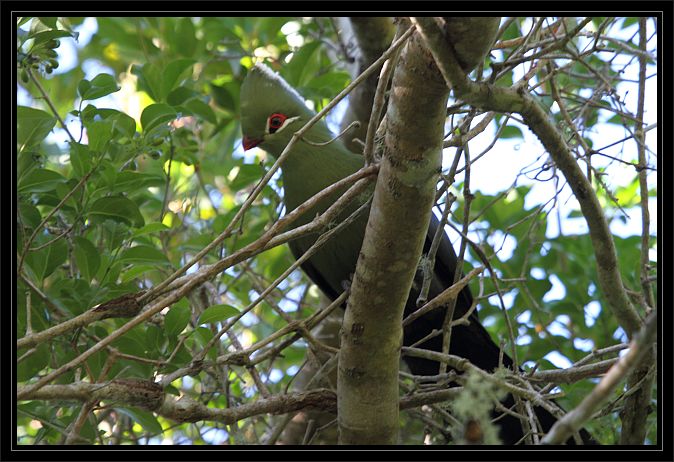ORDER MUSOPHAGIFORMES. Family Musophagidae
Description: The Knysna Turaco is a large turaco – 40-42 cm from beak to tail, 260-380 g -, one of a group of African near-passerine birds. It is a resident breeder in the mature evergreen forests of southern and eastern South Africa. It is an unmistakable bird, although often inconspicuous in the treetops. It was formerly sometimes considered to be a subspecies of the Green Turaco of West Africa but vocal and chromosomal differences have now led to it being classified as a specie of its own.. The easiest way to identify it from other green turacos is by the white tip on its rounded crest.
The Knysna Turaco has a sharply curved short but thick orange-red bill and a white line just under the eye that contrast with its mainly green plumage. It has a tall green crest, which is tipped with white. The eye is brown and the eye-ring deep red. In flight, Knysna Turaco shows conspicuous red primary flight feathers. Sexes are similar.

Distribution: Found almost exclusively in South Africa, in the narrow strip of forest extending from Mpumalanga, through KwaZulu-Natal, Eastern and Western Cape provinces. Can be found also in Mozambique and Swaziland, though, with an estimated global extent of occurrence of 20 000-50 000 km, though most of its population is concentrated in coastal Eastern Cape and KwaZulu-Natal

Status: The global population size has not been quantified, but the species is not believed to approach the thresholds for population size criterion of the IUCN Red List (i.e. less than 10 000 mature individuals). Global population trends have likewise not been quantified, but populations appear to be stable so the species is not believed to approach the thresholds for the population decline criterion of the IUCN Red List (i.e. declining more than 30% in ten years or three generations). For these reasons, the species is evaluated as Least Concern. According to the CITES II, it is not globally threatened, but future population projections indicate it will be affected by coastal deforestation.
Habitat: Evergreen/riverine forests, from sea level to 1800m.
General habits: Knysna Turaco, is usually seen flying between forest trees, or hopping with agility along branches. Turacos are social, moving in small, noisy flocks.
Feeding habits: It feeds mainly on fruits and berries, with seeds, leaves, insects, and earthworms making up the rest of its diet.
Breeding habits: It nests at different times of the year, depending on the region. Adults form monogamous pair bonds, and both parents contribute equally to incubation, brooding and feeding.
Nest: Though social, Turacos nest solitarily. The nest is built by both sexes, and is a flimsy platform of twigs, placed in thick tangles of leaves in a tree or in dense creepers.
Eggs: It lays 1-2 eggs, which are incubated by both sexes, for 20-24 days.
Young: The chicks stay in the nest for about 22 days, after which they clamber around the surrounding branches. They attempt their first flight at about 28 days, becoming independent a few week after this. Adults feed their chicks predigested fruit. Young birds take about a year to develop full adult coloration. Juvenile birds have a shorter crest without the white tips.
Call: It has a loud kow-kow-kow-kow call.
Did you know: Turacos (the 10 species of the Tauraco and the 2 of the Musophaga) are the only birds to possess true red and green color. When you look at most birds, the color you are seeing is a reflection produced by the feather structure. The turaco's red pigment (turacin) and green pigment (turacoverdin) both contain copper. In fact, if you stirred a glass of water with a red turaco feather, the water would turn pink! In museum species, the pigments deepen with age because the copper begins to oxidize. These birds mannage to maintain their colors throughout the year. The Knysna Lourie is thought to use its red wing feathers to escape predators. Indeed, when it flies, the predators tend to focus on the most visible color and follow the red patch. As the Lourie lends and folds its wings, the red feathers of the wings become invisible and the Lourie has a chance of escaping unseen.

Reference:
1. Bird of Eden
2. Bird Forum


